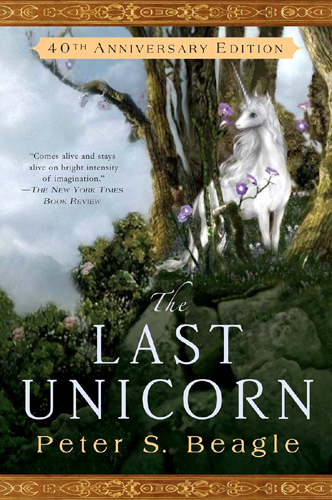I’m honestly not sure what I can say about The Last Unicorn that hasn’t been said before—folks were proclaiming the book a classic almost as soon as it was published, and certainly before I was born. Ursula K. Le Guin has paid tribute to Peter S. Beagle’s “particular magic,” Madeleine L’Engle described him as “one of my favorite writers,” and countless other readers, writers, and reviewers have heaped such a formidable mountain of praise at his door that it almost seems futile to approach, from down in the valley, and try to carve out some new flourish or clamber conveniently onto some hitherto unexplored perspective.
But even great monuments have their road signs, billboards, and tourist brochures, their aggressively fluorescent arrows pointing helpfully toward sites that really shouldn’t be missed. So consider this post a roadside marker, a glossy pamphlet, a helpful map to a well-worn path that’s much-travelled for a reason: the world of The Last Unicorn is always worth visiting, and revisiting, even if you think you’ve seen it all before.
Note: Spoilers for the plot and ending of The Last Unicorn below.
For no particular reason that I can think of, looking back, I didn’t actually read the novel until I was in my late teens, although I’d been obsessed with the animated movie version well before I could read. As faithful as the movie is (Beagle himself adapted the screenplay, and I’ll actually be discussing the film in a separate post later this week), I’ve always felt that the experience of reading the novel is markedly different from that of watching the film.* As a devoted and unapologetic fan of both versions, I don’t necessarily privilege one above the other, but the movie embroiders upon the simple elegance of the original story with its spectacular animation, its cast of well-known actors, its memorable soundtrack—it’s a tale well and richly told, and captures much of what makes the book so beloved. What resists translation from page to screen is what might be termed the literary angels’ share—the subtlety of writing that continuously loops in on itself and turns the reader into an unconscious co-conspirator, an acolyte (and, every so often, a comedic straight man).
*I should probably note here that I have not read the comic series published by IDW, although all the glimpses of the artwork I’ve seen have been gorgeous—if you’ve read them, please share your impressions in the comments!
The plot itself is a relatively straightforward quest narrative. It begins with the unicorn, alone in her lilac wood, spending the long years of her immortal existence in quiet, untroubled solitude until one day she overhears a pair of hunters debating the existence of unicorns. Shocked at their assertion that she is the last of her kind, she sets out in search of the others, finding the world much changed after so many years apart from it. The people she encounters have a longing for magic, miracles, and legends of the past, but are no longer capable of recognizing true magic when it appears, preferring cheap trickery and illusions.
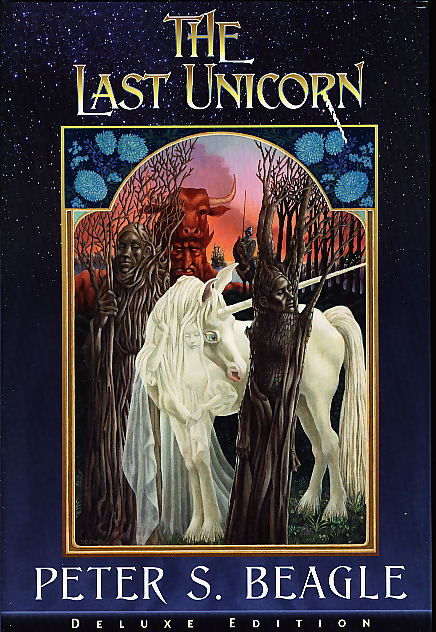 Out on the road, the unicorn is mistaken for a horse by men and sees no signs of her lost kin until she crosses paths with a rapturous, half-mad butterfly who recognizes her and names her, between reciting frantic snippets of songs, poetry, and jingles.* In a fleeting moment of clarity, he tells her that her people have been chased down by a creature called the Red Bull, and so she sets out again, only to find herself recognized and captured by a seedy hedge witch. Outfitted with a false horn (so that she may be seen by unknowing customers for what she truly is), the unicorn is put on display as part of Mommy Fortuna’s Midnight Carnival, a shabby collection of counterfeit monsters and one other true immortal creature: the harpy, Celaeno.
Out on the road, the unicorn is mistaken for a horse by men and sees no signs of her lost kin until she crosses paths with a rapturous, half-mad butterfly who recognizes her and names her, between reciting frantic snippets of songs, poetry, and jingles.* In a fleeting moment of clarity, he tells her that her people have been chased down by a creature called the Red Bull, and so she sets out again, only to find herself recognized and captured by a seedy hedge witch. Outfitted with a false horn (so that she may be seen by unknowing customers for what she truly is), the unicorn is put on display as part of Mommy Fortuna’s Midnight Carnival, a shabby collection of counterfeit monsters and one other true immortal creature: the harpy, Celaeno.
*Apparently, Beagle explains every reference, allusion, and in-joke woven into the Butterfly’s speech in “The Butterfly Decodex,” rumored to appear in his highly-anticipated collection The First Last Unicorn and Other Beginnings, due out on February 1st.
Finding an ally in the carnival’s would-be sorcerer, Schmendrick, the unicorn escapes (in one of the most harrowing and starkly, sadly beautiful passages in the novel) and returns to the road. Schmendrick tells her of the blighted country of King Haggard, where the monstrous Red Bull is rumored to dwell. He asks to join the quest, and—owing him her freedom—the unicorn agrees, although she already feels the cost of keeping company with a mortal, “the first spidery touch of sorrow on the inside of her skin.” The unicorn is not immune to human emotion or human weaknesses, although they are not natural to her, having kept herself apart from the world for so long, keeping watch over her forest and its creatures… In many ways, this is the heart of the story, beginning with this first shiver of sadness: how the unicorn changes, out in the world, no longer aloof and apart. It is not a straightforward lesson, and there is no glib, simplistic take-away moral at the end of the tale.
While there is a certain element of sadness and loss in the journey, however, it is counterbalanced with humor and liveliness—the tone of the book itself tends to veer between the heartbreakingly lyrical, disconcertingly insightful, and irreverently funny (much like the manic, poetry-spouting butterfly who sets the quest in motion—I’ve always thought of him as kind of a mascot for the novel as a whole).
As Schmendrick and the unicorn set out for Haggard’s kingdom, for example, we get a brief glimpse into the kooky marital problems of a pair of squabbling blue jays, right before Schmendrick gets drunk, offends the mayor of a nearby town with some unfortunate magical slapstick, and ends up kidnapped by a band of wanna-be, low-rent Merry Men under the dubious command of the self-aggrandizing Captain Cully, which is all pretty amusing. There’s something about Beagle’s use of offbeat, often anachronistic humor that strikes me as somehow intimate—it produces the same effect as, say, Groucho Marx turning to raise his eyebrows and address the audience, inviting you in on the joke.
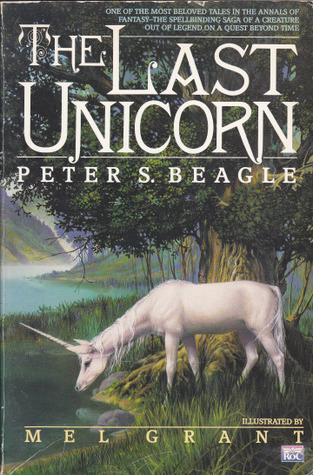 As an extension of this humor, Beagle constantly plays with the reader’s sense of time and place in a hundred small ways. In spite of the quasi-medieval setting of the tale with its peasants, knights, and kings living in stony, witch-raised castles, he sprinkles in the oddest details: Haggard’s men-at-arms wear homemade armor sewn with bottle caps; elsewhere, a bored princeling flips through a magazine; Mommy Fortuna talks about her act as “show business,” and Cully invites Schmendrick to sit at his camp fire and “[h]ave a taco.” Moments like these don’t jolt you out of the story—they’re more like a gentle nudge in the ribs, reminding you that there’s much more going on under the cover of the classic quest narrative driving things forward.
As an extension of this humor, Beagle constantly plays with the reader’s sense of time and place in a hundred small ways. In spite of the quasi-medieval setting of the tale with its peasants, knights, and kings living in stony, witch-raised castles, he sprinkles in the oddest details: Haggard’s men-at-arms wear homemade armor sewn with bottle caps; elsewhere, a bored princeling flips through a magazine; Mommy Fortuna talks about her act as “show business,” and Cully invites Schmendrick to sit at his camp fire and “[h]ave a taco.” Moments like these don’t jolt you out of the story—they’re more like a gentle nudge in the ribs, reminding you that there’s much more going on under the cover of the classic quest narrative driving things forward.
It’s all part of the novel’s repeated questioning of what qualifies as “real” and what is legend or fantasy, and whether those categories are mutually exclusive. Part of the humor comes from the characters’ own awareness of the conventions of myth and folktales: you get the definite impression that these characters know their Joseph Campbell, especially when delivering lines like, “I know the birth of a hero when I see it….[h]ad it not been for the cats, I would have chanced the child, but they made it so obvious, so mythological.” Captain Cully—whose fondest dream is to have songs of his derring-do “field-recorded” and included in the Child Ballads—is something of an expert on the subject of myths, declaring Robin Hood to be “a classic example of the heroic folk heroes synthesized out of need. John Henry is another.” He is a mercenary fraud as a would-be folk hero, but he hopes to provide the tiny grain of reality around which a legend can grow, regardless of authenticity.
His companion, Molly Grue, argues that Cully has it backward, and only legends like Robin and Marion are truly real. A disappointed dreamer, Molly is world-weary, but not cynical enough that she cannot recognize the unicorn immediately for what she is, the embodiment of a hope that she had long ago given up on. Slipping away from Cully and his band of brigands, Molly joins the questing party (much to Schmendrick’s dismay) and begins to mellow and blossom in the presence of the unicorn as they venture into Haggard’s lands.
They soon reach the strangely prosperous town of Hagsgate, and learn that both the king and the townspeople have been cursed by the witch who built Haggard’s castle, towering at the edge of a cliff above the sea. While the castle stands, the town will thrive, and only a child of the town can destroy it—they suspect Haggard’s adopted heir, Prince Lír, of being the hero born to bring the witch’s curse to fruition (according to the usual signs and portents, of course), and try to bribe Schmendrick to murder the prince. Molly is horrified by the fact that the townfolk tried to murder Lír as a baby, to which Schmendrick characteristically replies:
Well, if they hadn’t, he couldn’t have grown up to be a prince. Haven’t you ever been in a fairy tale before? […] The hero has to make a prophecy come true, and the villain is the one who has to stop him—though in another kind of story, it’s more often the other way around. And a hero has to be in trouble from the moment of his birth, or he’s not a real hero. It’s a great relief to find out about Prince Lír. I’ve been waiting for this tale to turn up a leading man.
Leaving the town behind, our heroes encounter the Red Bull at last. The unicorn finds herself utterly powerless against the Bull, who drives her relentlessly toward Haggard’s castle. In an attempt to save her, Schmendrick is able to summon up true magic, although he cannot control it, and the unicorn awakes in the body of a young, mortal girl—a body she can feel dying all around her. In spite of the trauma, the three continue on to the castle and meet Haggard, grim and mistrustful, and Lír, who is soft, puppyish, and instantly infatuated with the strange young girl hastily introduced as the Lady Amalthea, Schmendrick’s, um, niece. (I do love that Schmendrick has a handy knowledge of Greek mythology to fall back on even when fumbling for a believable explanation for the presence of his suspiciously ethereal, newly-minted mortal companion…)
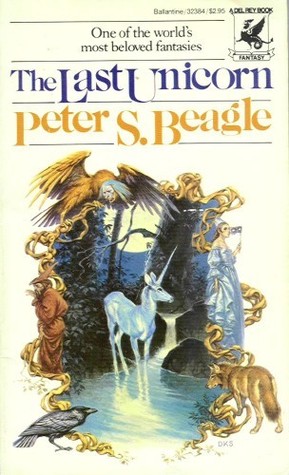 Both Haggard and Lír are instantly transfixed by Amalthea—Haggard suspects something of her unicorn nature, while Lír attempts every heroic deed in the book, from ogre-fighting to dragon-slaying to damsel-rescuing, in an attempt to get her attention. He turns himself into a mighty knight, but she does not notice him at all, too lost and confused in her new human body. Time passes, Molly and Schmendrick are no closer to discovering the whereabouts of the Bull or the missing unicorns, and Amalthea is so distraught and plagued by nightmares that she finally turns to Lír, falls in love, and begins to grow more and more human, gradually forgetting herself and her quest.
Both Haggard and Lír are instantly transfixed by Amalthea—Haggard suspects something of her unicorn nature, while Lír attempts every heroic deed in the book, from ogre-fighting to dragon-slaying to damsel-rescuing, in an attempt to get her attention. He turns himself into a mighty knight, but she does not notice him at all, too lost and confused in her new human body. Time passes, Molly and Schmendrick are no closer to discovering the whereabouts of the Bull or the missing unicorns, and Amalthea is so distraught and plagued by nightmares that she finally turns to Lír, falls in love, and begins to grow more and more human, gradually forgetting herself and her quest.
But of course, as Lír eventually points out, “Things must happen when it is time for them to happen. Quests may not be simply abandoned; prophecies must not be left to rot like unpicked fruit; unicorns may go unrescued for a long time, but not forever. The happy ending cannot come in the middle of the story.” Molly gets a tip from a talking cat, Schmendrick performs a bit of trickery with some wine and a gossip-y skull, and suddenly everyone is running through the tunnels under the castle, toward the Bull’s lair.
Amalthea pleads with Schmendrick, telling him that she wants to stay mortal and marry Lír…but Lír knows that he has become a true hero, and as a hero he must see the quest through. And so the story plays out: the hero sacrifices himself for love, and his sacrifice changes everything. The magician finally comes into his own, one curse is broken, a prophecy is finally fulfilled, the Bull is defeated, Haggard falls, and the unicorns of the world are freed, streaming out of the sea and back to their forests, leaving only the last behind.
The unicorn stays for a moment: she revives Lír and then leaves him with Molly and Schmendrick on the beach, looking back only once. Their part in her story has ended, or vice versa, and Schmendrick insists that they must let her go: Lír is now king with great deeds in need of doing, and Molly and Schmendrick have their own story to follow. Is it a happy ending? Yes, but like everything else in this story, “happy” is neither clear-cut or simplistic—there has been death, and loss, and the unicorn will never be the same again, having learned love and then regret. Happy doesn’t mean that everyone gets everything they want, in the end, but their shared farewell means the start of other stories…life goes on, and spring has returned to the cursed lands, and we get the definite sense that there will ups and downs ahead and plenty of good humor to see people through both.
Somehow, after all the talk of myth and stories and what’s real and what’s not real, you feel somehow that in the end, you’ve been given something remarkably honest—a story that’s not about what’s true or not true, but one that accepts that there’s some truth scattered through almost everything, glinting beneath the deadly serious as well as the completely ridiculous, the patterns of literary conventions and the randomness of real life. This is in large part thanks to the metafictional playfulness of characters who gleefully deconstruct their own stories in the telling: Captain Cully, with his oddly academic approach to being a merry outlaw and his overtly practical approach to personal mythmaking, and certainly Schmendrick and Lír, with their canny awareness of the fairy tale unfolding beneath their feet, and their own respective roles to play. Just as they humanize the unicorn in the story, changing her, they transform her story itself, stretching out the stiff material of the lofty quest narrative into something more comfortable and familiar, loved and lived-in, but still beautiful and strange.
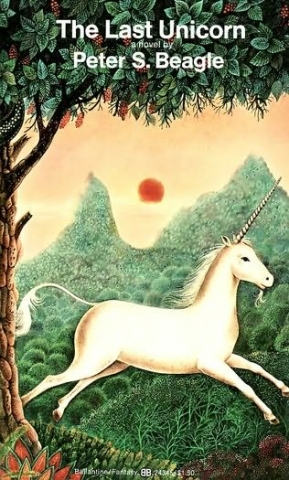 Over the course of this most recent reread of the novel, I’ve been thinking that it’s well and good to call a book a classic and give it a place of pride on your shelves and pick it up now and again when the mood strikes you, but there are certain books that should be shared and talked about far more often than they are. The Last Unicorn is not a difficult book—it is as smooth and graceful as its mythical protagonist, satisfying, resonant, self-contained, with hidden depths. It is a pleasure to read, even in its most bittersweet moments, and I wonder if, in some strange way, it gets overlooked at times because of its pleasurable nature.
Over the course of this most recent reread of the novel, I’ve been thinking that it’s well and good to call a book a classic and give it a place of pride on your shelves and pick it up now and again when the mood strikes you, but there are certain books that should be shared and talked about far more often than they are. The Last Unicorn is not a difficult book—it is as smooth and graceful as its mythical protagonist, satisfying, resonant, self-contained, with hidden depths. It is a pleasure to read, even in its most bittersweet moments, and I wonder if, in some strange way, it gets overlooked at times because of its pleasurable nature.
Readers (and perhaps fantasy and science fiction readers more than most) love to discuss and champion challenging and complicated works—the hulking epics, the novels and series that require charts and glossaries and intricate timelines and family trees delineating generation upon generation’s worth of characters and world-building. I certainly do, at least—give me some decent intrigue and an impossibly large cast of characters and I’m swinging through fictional family trees like some kind of deranged literary Tarzan, gleefully penciling in notes along the way. I’m not suggesting that less is more, or that simpler fictions are innately superior to more complicated ones (or vise versa), but I do think that it can be easier to overlook a profound story told in simpler form.
A book like The Last Unicorn is not less significant because it is a pleasure—there is nothing remotely fluff-like about it, and if you read it closely and pay attention, you’ll be rewarded with the revelation of just how perfectly and subtly its form fits its meaning. It is a story about stories, the nature of reality, and how things can be both more and less than they seem, and as you read along you’ll find that its questions have become your own, that every choice that you make about how to feel and react and interpret is a part of the overall tale—not the simple quest that drives the plot, but the underlying story of what kind of world we live in, and what kind of people we really are.
So while I’m not sure I have anything new to say about the book, I still feel that it’s important to say this much, and to continue rereading and recommending it—for the journey, and because it is a thing of beauty, and poses the kind of questions that are always worth meditating upon.
Bridget McGovern is the managing editor of Tor.com, and thinks that somebody should take a cue from Lír and start a “Baby Heroes Rescued By Cats” tumblr right away. The internet will not be able to resist.










